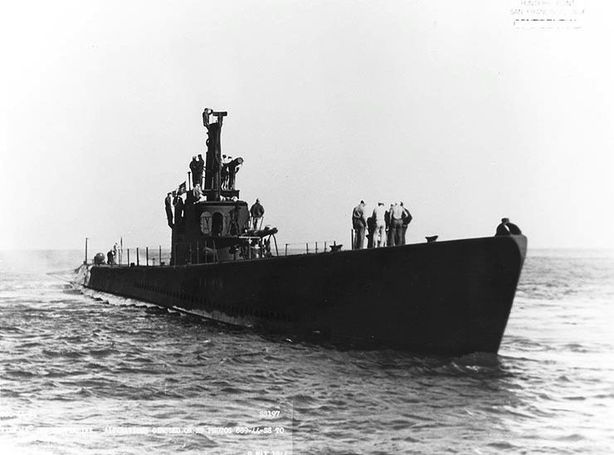 Google Image USS Seawolf
Google Image USS Seawolf I had just written a story about my first boat ( http://www.grangerlandrfd.com/subs-my-first-boat-ss343.html ) when I ran across a thread on facebook that caused a flood of memories to come rushing back. The trigger was a picture of the Seawolf. I had not thought about her in a long time but she was a unique boat. One of the members of a FB submarine forum said he had earned his Dolphins on her between 66-68. I asked him if he had been on board during a certain incident and he confirmed that he had.
I have a minimum of inside information on the incident but did have a ringside seat. I have asked this submariner to comment on this post and am waiting until he does to announce it's release to my friends on fb. After all, the pig and the chicken have differing investments in a ham and egg breakfast. I would expect him to remember things differently than I and with greater certainty. More after a brief history.
Seawolf is a name that has been attached to 3 Navy Submarines. The boat pictured here acquitted itself quite well in WW2. She was last heard from in 1944. She sank a bunch of tonnage but wound up being one of the fifty submarines lost in the Pacific. It actually earned quite a reputation but this is not about that Seawolf, only its name. Among others, you can thank the Seawolf for not having to speak Japanese.
There was no third wave of bombers to attack the submarines and fuel tanks at Pearl. That was a grave mistake that was fortunate for us. History may change depending on who is writing it but I think it is set in stone that submarines sank more tonnage than all other types of warfare combined. We lost 50 submarines in the Pacific and 2 in the Atlantic during that time. A namesake of this boat became SSN575, and was an active participant in the "cold war" for the majority of that war. I hope the submariners on SSN21 (today's version) know the load of tradition they are carrying.
I have a minimum of inside information on the incident but did have a ringside seat. I have asked this submariner to comment on this post and am waiting until he does to announce it's release to my friends on fb. After all, the pig and the chicken have differing investments in a ham and egg breakfast. I would expect him to remember things differently than I and with greater certainty. More after a brief history.
Seawolf is a name that has been attached to 3 Navy Submarines. The boat pictured here acquitted itself quite well in WW2. She was last heard from in 1944. She sank a bunch of tonnage but wound up being one of the fifty submarines lost in the Pacific. It actually earned quite a reputation but this is not about that Seawolf, only its name. Among others, you can thank the Seawolf for not having to speak Japanese.
There was no third wave of bombers to attack the submarines and fuel tanks at Pearl. That was a grave mistake that was fortunate for us. History may change depending on who is writing it but I think it is set in stone that submarines sank more tonnage than all other types of warfare combined. We lost 50 submarines in the Pacific and 2 in the Atlantic during that time. A namesake of this boat became SSN575, and was an active participant in the "cold war" for the majority of that war. I hope the submariners on SSN21 (today's version) know the load of tradition they are carrying.
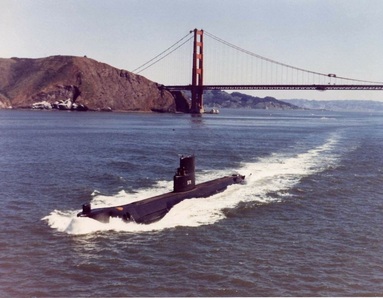 Google Image USS Seawolf SSN575
Google Image USS Seawolf SSN575 This, SSN575 is the submarine that I knew. More accurately, I was acquainted with several of her crew members from that time frame. When in New London we frequented the same watering hole. We were the sort of casual acquaintances one makes when you know you are on the same team. You become very friendly but not truly friends.
Honestly I don’t remember if this boat tied up at the Submarine Base or if they were across the river at the tender as the Nukes sometimes were. Neither of us were in port enough to care. We were out for the better part of ten months of the first twelve I spent on an operational boat.
The Seawolf was the second nuclear submarine and there were several differences between the first (Nautilus), her, and the Skate class that followed.
I was an ear witness to that near tragic accident the Seawolf had in January, 1968. I remember it as being an operation in the Bay of Maine. I research almost everything I put on this blog because if I can find it on the internet I consider it to be currently unclassified. Wikipedia says it was about 65 miles east of Cape Cod. If that is a contradiction, I will go with what I read.
I was the ships corpsman "Doc" on the Clamagore (SS343) and I stood watch in Sonar. Frankly I do not remember if I was actually sitting on the passive gear or doing something else. It didn't matter because everyone in the room could hear clearly. I don’t know what the Seawolf was specifically doing but she started up and was moving somewhere reasonably fast.
The first generation Nuke, despite the advantage of nuclear power, was a noisy machine. I was told that it was because of the reduction gear that managed all that power from the steam turbine. A diesel was much quieter in those days (unless the engines were running) but that has all changed.
Regardless, the Seawolf sounded like it was right next door. Our equipment said it was over 10 miles away. Our conning tower questioned us on how near they were because they could hear them very clearly over the underwater phone.
Honestly I don’t remember if this boat tied up at the Submarine Base or if they were across the river at the tender as the Nukes sometimes were. Neither of us were in port enough to care. We were out for the better part of ten months of the first twelve I spent on an operational boat.
The Seawolf was the second nuclear submarine and there were several differences between the first (Nautilus), her, and the Skate class that followed.
I was an ear witness to that near tragic accident the Seawolf had in January, 1968. I remember it as being an operation in the Bay of Maine. I research almost everything I put on this blog because if I can find it on the internet I consider it to be currently unclassified. Wikipedia says it was about 65 miles east of Cape Cod. If that is a contradiction, I will go with what I read.
I was the ships corpsman "Doc" on the Clamagore (SS343) and I stood watch in Sonar. Frankly I do not remember if I was actually sitting on the passive gear or doing something else. It didn't matter because everyone in the room could hear clearly. I don’t know what the Seawolf was specifically doing but she started up and was moving somewhere reasonably fast.
The first generation Nuke, despite the advantage of nuclear power, was a noisy machine. I was told that it was because of the reduction gear that managed all that power from the steam turbine. A diesel was much quieter in those days (unless the engines were running) but that has all changed.
Regardless, the Seawolf sounded like it was right next door. Our equipment said it was over 10 miles away. Our conning tower questioned us on how near they were because they could hear them very clearly over the underwater phone.
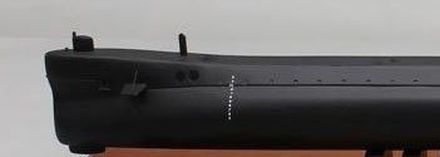 Google Image USS Seawolf SSN575
Google Image USS Seawolf SSN575 The passive gear that I was referring to was our version of the machinery that gives us our underwater ears. Here it is represented on this model of the Seawolf by the little bump on the chin (bottom left) of the picture. Sound travels wonderfully well in the water, and you can just set there and listen to the sounds that life makes. It's just like listening to the radio.
Suddenly we heard a tremendous bang and some scattered noise followed by silence. We may have heard tanks blowing but that doesn’t last long and I have forgotten.
It developed, we were told, that the Seawolf had hit straight on into an underwater mountain. I don’t know about their equipment but in my boat smacking your sonar dome into a mountain would have meant instant flooding. There was a big barrel valve in Sonar that you need to shut quickly to keep from taking on water. I Imagine they were faced with the same problem. True or not, there was no time to spare for reflection on what happened.
Our Conn was screaming at us wanting to know what was going on. They were able to hear it on the underwater telephone. We told them it sounded like the Seawolf had hit something but obviously had no further information.
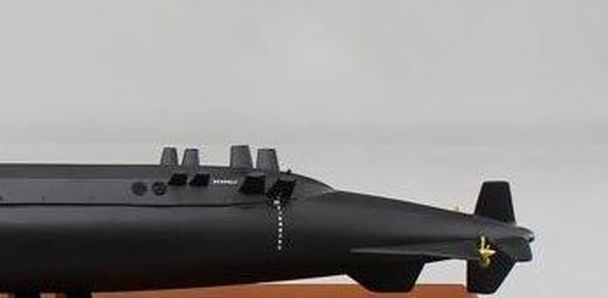 Google Image USS Seawolf SSN 575
Google Image USS Seawolf SSN 575 We were told later that the blow made the nose go up and the tail go down. In this case it struck the rudder that you see hanging down. I think I also was told that the stern was partially buckled. Now, when they were lucky enough to get to the surface there was no steering. The picture below shows the port screw (left propeller). As you would expect there is one on the opposite side.
The fin dropping below that is the rudder with stern planes sticking sideways in the wake of each screw. There is rudder shooting up as well. I do not believe the fin to your left in the picture had a function other than stability. Those personnel still standing would have been blowing air into all tanks to make it to the surface. We were never told but there may have been flooding both forward and aft.
We headed off in the direction of the sound that was made as fast as we could. Sure enough they were as far away as our range finding sonar said they were. The deck gang ensured that we could get to the mooring lines while waiting to see what developed. I was not topside so I don't know if we actually anchored at the scene or off scene awaiting instructions.
A tug was dispatched from New London and when it arrived the next episode happened. First the Seawolf had to survive. There were rocks around and grounding on them could have meant losing the ship. This is supposition on my part. Sonar was relegated to being a spectator.
I do not know if they lost power but there is emergency power (diesel/battery) available on the Nukes. It's primary job was to restart the reactor but I believe it can be pressed into service in an emergency.
The fin dropping below that is the rudder with stern planes sticking sideways in the wake of each screw. There is rudder shooting up as well. I do not believe the fin to your left in the picture had a function other than stability. Those personnel still standing would have been blowing air into all tanks to make it to the surface. We were never told but there may have been flooding both forward and aft.
We headed off in the direction of the sound that was made as fast as we could. Sure enough they were as far away as our range finding sonar said they were. The deck gang ensured that we could get to the mooring lines while waiting to see what developed. I was not topside so I don't know if we actually anchored at the scene or off scene awaiting instructions.
A tug was dispatched from New London and when it arrived the next episode happened. First the Seawolf had to survive. There were rocks around and grounding on them could have meant losing the ship. This is supposition on my part. Sonar was relegated to being a spectator.
I do not know if they lost power but there is emergency power (diesel/battery) available on the Nukes. It's primary job was to restart the reactor but I believe it can be pressed into service in an emergency.
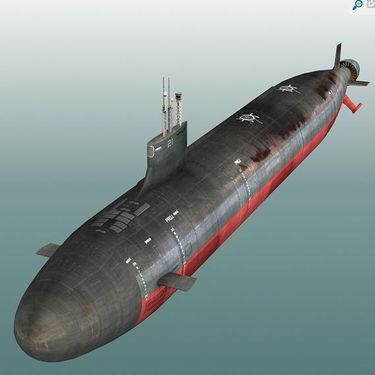 Google Image USS Seawolf SSN21
Google Image USS Seawolf SSN21 This is the latest generation of Seawolf and it could not have done what the 575 boat did next.
If you have two screws and the first generation nukes all did, you can steer using the screws. If you order starboard (right) screw (propeller) forward and port (left) screw (propeller) aft, you will turn to the left or vice verse. We use it to increase steering capability when we are in maneuvering watch going into port or in emergency situations. It is that rudimentary capability to steer and propel that kept them out of harms way.
If you have two screws and the first generation nukes all did, you can steer using the screws. If you order starboard (right) screw (propeller) forward and port (left) screw (propeller) aft, you will turn to the left or vice verse. We use it to increase steering capability when we are in maneuvering watch going into port or in emergency situations. It is that rudimentary capability to steer and propel that kept them out of harms way.
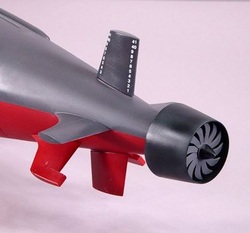 Google Image USS Seawolf SSN21)
Google Image USS Seawolf SSN21) As you can see there is one shrouded screw on the SSN21. She could not have done that and might have drifted onto the rocks and ended up with a hole in her side.
When the tug arrived there was no need for us to remain on the scene or anybody to operate with. If I recall correctly we went home. Two of my friends did not fare so well. That is the next stage of the incident I referred to above.
One who looked as though he could have been a wrestler and his sidekick who was a small guy were hooking up a nylon tow line from a tug. These things may be as thick as your wrist when they are unstressed. If they start getting thinner and start to hum you should take cover. That happened when they were placed in tow. The line snapped or came loose and my two friends were thrown into the water. The small guy came out pretty well but my large muscular Torpedoman friend had his femur snapped when the line parted.
We had known that this was an exceptional boat but I really didn’t know how much till later. I knew they had been on a mission and were to return. If I hadn't known that the crew had their act together just by the feat of surviving, I did when I read their story in the book titled "Blind Mans Bluff".
When the tug arrived there was no need for us to remain on the scene or anybody to operate with. If I recall correctly we went home. Two of my friends did not fare so well. That is the next stage of the incident I referred to above.
One who looked as though he could have been a wrestler and his sidekick who was a small guy were hooking up a nylon tow line from a tug. These things may be as thick as your wrist when they are unstressed. If they start getting thinner and start to hum you should take cover. That happened when they were placed in tow. The line snapped or came loose and my two friends were thrown into the water. The small guy came out pretty well but my large muscular Torpedoman friend had his femur snapped when the line parted.
We had known that this was an exceptional boat but I really didn’t know how much till later. I knew they had been on a mission and were to return. If I hadn't known that the crew had their act together just by the feat of surviving, I did when I read their story in the book titled "Blind Mans Bluff".
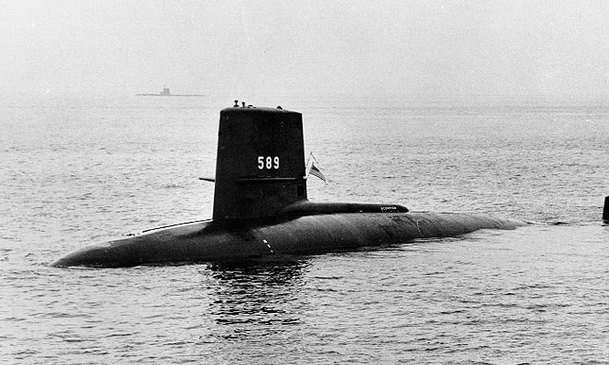 Google Image image of the USS Scorpion SSN589. Lost.
Google Image image of the USS Scorpion SSN589. Lost. http://forum1.aimoo.com/American_Cold_War_Veterans/Cold-War-Casualties/Naval-Accidents-During-Cold-War-1-1579633.html
This link has a self explanatory title. I bring it up because of the time frame in which this story is set. Over this time (2 year period), I believe I counted 16 incidents involving submarines. Five involved the loss of the ship. Now I cannot believe the mountain jumped out and hit the Seawolf but I must tell you the world was hot during that time. French, Israeli, Soviet, and American submarines were lost.
I don't think it can be called paranoia when incidents like these are actually happening. I really think this time frame is worth another article but don't know if I can do it justice.
This link has a self explanatory title. I bring it up because of the time frame in which this story is set. Over this time (2 year period), I believe I counted 16 incidents involving submarines. Five involved the loss of the ship. Now I cannot believe the mountain jumped out and hit the Seawolf but I must tell you the world was hot during that time. French, Israeli, Soviet, and American submarines were lost.
I don't think it can be called paranoia when incidents like these are actually happening. I really think this time frame is worth another article but don't know if I can do it justice.
 RSS Feed
RSS Feed